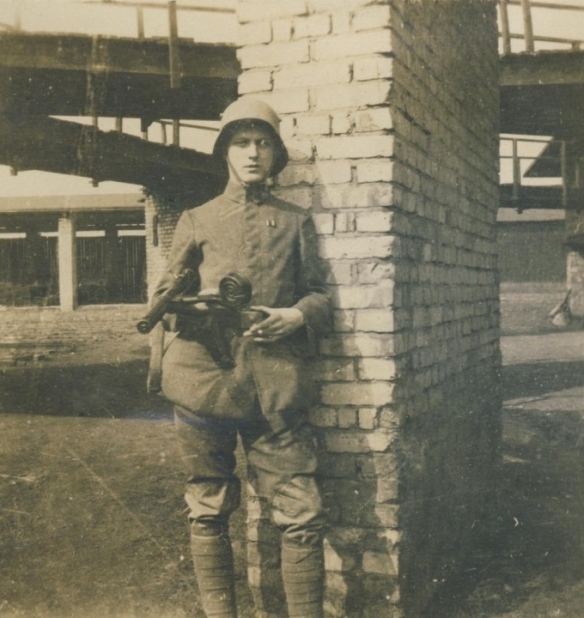A German soldier with an MP18 in Northern France, 1918.
One weapon of close combat that has been associated with German assault troops is the MP18 submachine-gun. The German Army had been swift to perceive the potential for highly portable, short-range, automatic weapons and had begun experimenting with various concepts from 1915 onwards. In 1916 they had tested a fully automatic version of their 9mm Pistole 08 Lange (the long barrelled Luger pistol). However, it was found to be uncontrollable and to have too fast a rate of fire. Similar problems were found with a fully automatic ‘carbine’ version of the Mauser C96 pistol. Unlike the Austrians and the Italians, the Germans were not prepared to live with such faults. Finally, in 1917, the designer Hugo Schmeisser developed a promising machine pistol for the consideration of the military, and his design was taken up by the Theodor Bergmann Waffenbau. The history of this weapon, commonly known as the MP18, I (or, less regularly, as the Bergmann Muskete) is shrouded in mystery and has become the basis of not a little myth-making.
Schmeisser’s design took the barrel of the long-barrelled Luger and combined it with a blowback action comprising a firing-pin riding inside a heavy bolt, which were driven into battery by a return spring. The weapon had a wooden stock and used the 32-round ‘snail-drum’ magazine already in production for use with P08 Lange. The peculiar magazine was the weak link in an otherwise workmanlike design. Nonetheless, if the weapon was going to be adopted, the use of existing components like the magazine and barrel was very much in its favour. However, the question of official adoption is one of the mysteries that dog the MP18. At least one expert has suggested that Schmeisser’s gun was never officially taken into service. The designation ‘18, I’ may in fact relate to the Treasury budget which governed expenditure on such items.
In most armies however, Official adoption was frequently only a rationalization of an issue that had already taken place. The MP18 certainly did see use in the field, whether adopted or not, but further mystery lies in the timing and scale of this use. The MP18 has frequently been seen as the very acme of the various weapons associated with the German stormtrooper – particularly in the context of the spring offensives of 1918. Sadly for this myth, the instruction manual for the MP18 was only produced in April 1918 and, while ‘adoption’ might follow issue, dissemination of instruction manuals invariably precedes it! It appears clear that the MP18 only began to appear in the field from the summer of 1918 onwards. Examples with surviving provenance tend to have been captured in the last two months of the war. A rare reference to their issue appears in the history of the 104th Infantry Regiment, which describes them as a valuable supplement to automatic fire against enemy assaults (Sturmabwehr)in the ‘last months’.
The numbers of MP18s which saw combat were probably very limited. Much discussion has been devoted to the scale of this weapon’s production – with figures of over 30,000 being quoted by some authorities. In fact, the serial numbers of surviving examples of this weapon known to have been captured at the Front do not appear to go beyond the 5,000 mark. The picture has been obscured by the fact that those MP18s issued after the war, to the police forces of the Weimar Republic, were either renumbered, or used a new range of numbers after being assembled from wartime parts. In at least some cases renumbering appears to have been achieved by the simple expedient of adding a digit in front of the original serial number – hence the existence of MP18s with numbers in the 30,000 range.
While it is certainly very likely that assault battalions got their hands on the new weapon, the Official intention was to make a general issue of the MP18 to the infantry. Each infantry company was to have a seven-man Maschinenpistole team (one gunner and six ammunition carriers). As the meagre production figures imply, it did not prove possible to implement this plan before the Armistice. The terms of the subsequent peace treaty have been at the root of one further myth regarding the MP18. It is frequently repeated as fact that the Bergmann Muskete had so impressed the Allies during the 1918 campaign that they specifically banned its production and military issue. In fact no such prohibition appears in the terms of the Treaty of Versailles. Strict controls were placed on the production of fire arms – principally by means of severely limiting the number of companies permitted to manufacture war materials – Bergmann was not among them. With regard to military issue, the numbers and types of weapons permitted to the 100,000-man German Army were carefully stipulated. There is no mention whatsoever made of machine pistols, although every other weapon type (apart from pistols) is listed – from cavalry carbines to 105mm Howitzers. Given the care that was taken to lay down such specific restrictions, it would appear that, far from having impressed the Allies, the MP18 had not really registered on their consciousness at all. The fact that they were still unconvinced of the utility of such weapons on the eve of the Second World War would also suggest that the impact of the MP18 on the fighting of 1918 was marginal.
